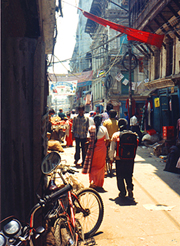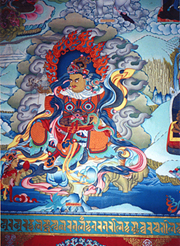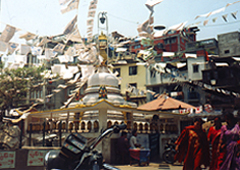| The dusty journey from Varanasi was a solid two days, and my beleaguered stomach was in the final round of a title bout with dysentery. I was awfully far from home, and I confess to wishing for a comfortable bed and some mindless television. Descending into the Kathmandu Valley from the West, however, my doubts were washed away like so many flies off a water buffalo�s back. The city was bursting with color and history. Tibetan prayer flags seemed to cover it like a web, strung from windows to temples to parked trucks. It was all too easy to get lost in the labyrinth of twisting and confining streets, always unmarked in the fashion of a medieval city planned by circumstance, not by design. Around every corner sat a centuries-old Buddhist stupa, a wonder somehow made mundane by the density and vibrancy of the city. Shiva sat alongside Buddha as sari mingled with Tibetan peasant dress. In distinctly Nepali fashion, there are both Buddhist and Hindu stories about the origin of the Kathmandu valley, and most accounts make use of both perspectives. The Buddhist legend stars Manjushri, a Chinese deity who cleaved a lakeshore with a great sword, draining the water and creating the Kathmandu valley. The Hindu version of the tale is similar, though it attributes the deed to Indra, who let loose a thunderbolt to create the Chobar Gorge. Whatever its origins, the human history of the valley begins with a tribe that arrived from the east in the 7th or 8th century BC. Buddhism arrived in the valley during this period and was joined by Hinduism around 300 AD. A history of tolerance by adherents of both religions and by Nepali royalty has allowed the two religions to exist side-by-side ever since, often merging in the everyday practices of the Nepali people |
| Buddha Meets Shiva at the Intersection of 2 Unnamed Streets A writer encounters prayer flags, a monkey temple, & a living goddess in Kathmandu |
| On one of my last days in Nepal, I undertook a day�s walk through the Kathmandu valley. It was harvest season, and peasants were spreading their wheat out on the road so that the weight of an occasional passing car or truck could help separate out the chaff. Tiny villages passed by as I began to feel myself slip into another world.As I rounded a bend, I saw a pair of quaint, rickety barns in the distance. Nearing them, however, I saw a familiar logo emblazoned on the roof of the first � Pepsi. The next barn � Coke. If the 1980s saw the Cold War play itself out in less industrialized communities around the world, the 1990s saw the Cola War step into its place. Inwardly shaking my head, I reminded myself that romanticism is best tempered by pragmatism, and that globalization extends even to places that strike the naive American as otherworldly and untouched. Perhaps I wasn�t so far from home after all. |
 |
 |
 |